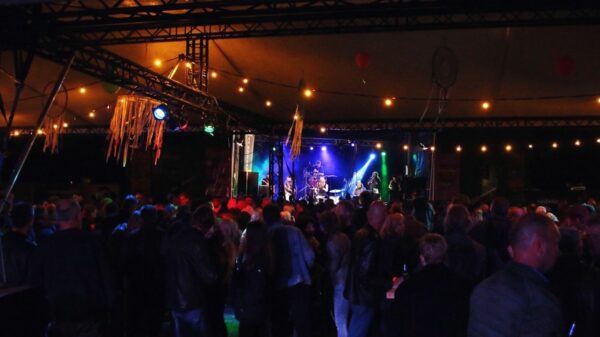Staff writer Oisín McGilloway looks back at “The Last Wave”, an Australian film highlighting the impact of colonialism on our ways of thinking.
“The past is a foreign country; people do things differently there”.
This quote, from L.P. Hartley’s 1953 book “The Go-Between”, speaks to an excuse made by all of us about the past. All things that have happened, have happened in the past, including those things we would rather forget. Our separation from them now, being in the present, is enough of a reason to forget, granted. But our separation from them also allows the memory of these bad things to augment and fester in our minds, making them very hard, in the long run, to get rid of.
It was this idea that became the basis of Peter Weir’s 1977 film “The Last Wave”, which was recently brought back to the big screen during the London Australian Film Festival (LAFF). The film follows Sydney lawyer David Burton, played by Richard Chamberlain, as he tries to build a defence for five Aboriginal people who have been accused of murder by understanding the mystique of Aboriginal history.
The supposed mystique of Aboriginal history is exactly what the film seeks to criticise: the mystification of Aboriginal culture that has been used to excuse so much colonialist activity (for example, that which resulted from the “outstation” movement of Aboriginal people to remote settlements to regain autonomy in the 1970s and 80s). Weir’s portrayal of this, however, doesn’t come through in the Aboriginal characters — one of whom is played by David Gulpilil, whose performances are a focus of this year’s festival — but rather through Burton’s white guilt for their ostracism, translated through the dreams and premonitions that he experiences more and more as he delves deeper and deeper into Aboriginal “Dreamtime”, trying to find the answers to unanswerable questions. In a world where heritage and identity are becoming more and more prominent in political discourse, Weir’s film seems to be speaking of a time that has never been more apparent than now.
The “Dreamtime” perception of the world, a tradition in Aboriginal culture, presents the idea of “Everywhen”; that all past, present, and future exist as one (to simplify an age-old concept). To Burton, this idea appears in premonitions of incoming apocalyptic events, like a deadly storm and a tidal wave that will wipe out Sydney. To show how these dreams are affecting Burton’s grip on reality, Weir forces the same confusion on his audience through story structure and the muddled order in which events unfold. Very rarely is it obvious to us when Burton is dreaming and when he is awake. He dreams of the tidal wave submerging Australia, but in sequences that we assume are real, it is raining — is he envisaging events that are yet to happen? Or have they already happened, and the story is actually told retrospectively? Or is the whole apocalypse just a figure of his imagination? We see the sequence of Burton returning home to his family twice — which one was real? Or were they both real? Burton dreams things that happen later in the film, things that he couldn’t possibly have known about, tapping into the inescapable, subliminal guilt felt by many colonising people towards their colonised counterparts about the atrocities committed by their ancestors. With the confused, dream-like structuring of the story, everything seems to happen at once in a filmic presentation of the “Everywhen”, bringing the apocalyptic future that reduces all of us equally to the futile humans we are, as well as the savagery of the colonial past, to one moment in the present.
Humanisation is another approach Weir takes to present the plight of the Aboriginal people. David Gulpilil, who is arguably the star of the film, is himself a tribal Aboriginal. During the early part of his career, he would leave his community for the city, make films, and return home to his ancestral tribe. He, therefore, embodies the stupidity of mystifying and indeed oppressing the Aboriginal community, as living proof that Aboriginal people are not intentionally reclusive and understand that interpretation between races is the only real solution to the mess left by colonialism. Equally, the character of Charlie is also played by an Aboriginal actor, Nandjiwarra Amagula. Throughout the film, he doesn’t say a lot, but what he does say was lifted directly from conversations had with Weir in real life about “Dreamtime” and Aboriginal culture in general (like the idea of dreams as “shadows of reality” presented in the film). Weir connected himself to the people who represent this age-old culture, thus creating a much more concrete portrayal of the human connections we from the West share with them, which Rebecca Weaver-Hightower and Peter Hulme, in their 2014 book “Postcolonial Film: History, Empire, Resistance”, have posited as the “most direct interrogation of Australian identity” on film.
Another main theme of the film, that helps portray this disparity in culture and the humanity that invalidates it, is law. Burton is a lawyer, who works in the rules of law of the Western World; mathematical, procedural, and based on empirical truths. What he encounters by taking on this case, however, is Aboriginal tribal law — the reason given for the killing — which operates on a whole different set of emotional and traditional rules that go against most of what Burton’s Western law consists of. Weaver-Hightower and Hulme describe this as the “disparity of understanding between the urban landscape of Sydney and a unified, albeit dwindling Aboriginal culture”. As a result of colonisation and globalisation, Australia, particularly in its urban regions and like many other countries, has become a lot more measured and calculated in its worldviews, resting a lot less on the complexity of humanity. When Burton, a man whose mannerisms reflect the measured nature of his occupation, comes in contact with this tribal law, he opens himself up to the possibilities of humanity, and even uncovers his ancestral past as a descendent of the “Mulkurul” tribe of South Africa. What Weir is showing us is that the structure of the — notably white — modern world is that it ostracises groups like the Aboriginal people, as it has lost sight of the humanity that connects us all together. Furthermore, such a modernist structure, which scholar Gayatri Chakravorty Spivak, in her essay “Can the Subaltern Speak?”, has labelled the “banality of leftist intellectuals”, positions white guilt for colonialism in the field of the theoretical, rather than actually connecting with the people that it still affects today (an idea laid out by casting tribal Aboriginal people, as aforementioned, and in this comparison of “banal” law to tribal, “humanist” law).
There are many parts of the film that feel confusing; strands of narrative that don’t make a lot of sense, or that take a broader look at the film to understand, but this only goes to show how invalid colonialist hegemonies are. The idea of “dominant” ideas — which in almost all cases are white — are such purely because they derive from oppression, not because they are more logical or sound. In her 2015 article “An Authentic Dreamtime: David Gulpilil and The Last Wave” for “Senses of Cinema”, Lisa French focuses on how Weir shows us that Aboriginal knowledge is proof that “European ways of thinking do not explain all phenomena”. When boiled down, the complexity of culture across the globe is vast, but what connects us all is our humanity, and so these other “ways of thinking” should be embraced to get a better sense of the world we live in.
















